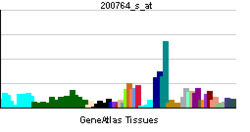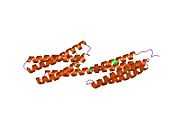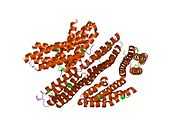Catenin (cadherin-associated protein), alpha 1
Catenin alpha-1 is a protein that in humans is encoded by the CTNNA1 gene.[1][2]
Interactions
Catenin (cadherin-associated protein), alpha 1 has been shown to interact with:
See also
References
- ↑ Herrenknecht K, Ozawa M, Eckerskorn C, Lottspeich F, Lenter M, Kemler R (November 1991). "The uvomorulin-anchorage protein alpha catenin is a vinculin homologue". Proc Natl Acad Sci U S A 88 (20): 9156–60. doi:10.1073/pnas.88.20.9156. PMC 52671. PMID 1924379.
- ↑ "Entrez Gene: CTNNA1 catenin (cadherin-associated protein), alpha 1, 102kDa".
- ↑ Su LK, Vogelstein B, Kinzler KW (December 1993). "Association of the APC tumor suppressor protein with catenins". Science 262 (5140): 1734–7. doi:10.1126/science.8259519. PMID 8259519.
- ↑ Daniel JM, Reynolds AB (September 1995). "The tyrosine kinase substrate p120cas binds directly to E-cadherin but not to the adenomatous polyposis coli protein or alpha-catenin". Mol. Cell. Biol. 15 (9): 4819–24. PMC 230726. PMID 7651399.
- ↑ Oyama T, Kanai Y, Ochiai A, Akimoto S, Oda T, Yanagihara K et al. (December 1994). "A truncated beta-catenin disrupts the interaction between E-cadherin and alpha-catenin: a cause of loss of intercellular adhesiveness in human cancer cell lines". Cancer Res. 54 (23): 6282–7. PMID 7954478.
- ↑ 6.0 6.1 Roe S, Koslov ER, Rimm DL (June 1998). "A mutation in alpha-catenin disrupts adhesion in clone A cells without perturbing its actin and beta-catenin binding activity". Cell Adhes. Commun. 5 (4): 283–96. doi:10.3109/15419069809040298. PMID 9762469.
- ↑ Piedra J, Miravet S, Castaño J, Pálmer HG, Heisterkamp N, García de Herreros A et al. (April 2003). "p120 Catenin-associated Fer and Fyn tyrosine kinases regulate beta-catenin Tyr-142 phosphorylation and beta-catenin-alpha-catenin Interaction". Mol. Cell. Biol. 23 (7): 2287–97. doi:10.1128/mcb.23.7.2287-2297.2003. PMC 150740. PMID 12640114. Vancouver style error (help)
- ↑ Aberle H, Butz S, Stappert J, Weissig H, Kemler R, Hoschuetzky H (December 1994). "Assembly of the cadherin-catenin complex in vitro with recombinant proteins". J. Cell. Sci. 107 (12): 3655–63. PMID 7706414.
- ↑ Reuver SM, Garner CC (April 1998). "E-cadherin mediated cell adhesion recruits SAP97 into the cortical cytoskeleton". J. Cell. Sci. 111 (8): 1071–80. PMID 9512503.
- ↑ Kinch MS, Clark GJ, Der CJ, Burridge K (July 1995). "Tyrosine phosphorylation regulates the adhesions of ras-transformed breast epithelia". J. Cell Biol. 130 (2): 461–71. doi:10.1083/jcb.130.2.461. PMC 2199929. PMID 7542250.
- ↑ Oneyama C, Nakano H, Sharma SV (March 2002). "UCS15A, a novel small molecule, SH3 domain-mediated protein-protein interaction blocking drug". Oncogene 21 (13): 2037–50. doi:10.1038/sj.onc.1205271. PMID 11960376.
- ↑ Navarro P, Lozano E, Cano A (August 1993). "Expression of E- or P-cadherin is not sufficient to modify the morphology and the tumorigenic behavior of murine spindle carcinoma cells. Possible involvement of plakoglobin". J. Cell. Sci. 105 (4): 923–34. PMID 8227214.
- ↑ Takahashi K, Suzuki K, Tsukatani Y (July 1997). "Induction of tyrosine phosphorylation and association of beta-catenin with EGF receptor upon tryptic digestion of quiescent cells at confluence". Oncogene 15 (1): 71–8. doi:10.1038/sj.onc.1201160. PMID 9233779.
- ↑ 14.0 14.1 Schmeiser K, Grand RJ (April 1999). "The fate of E- and P-cadherin during the early stages of apoptosis". Cell Death Differ. 6 (4): 377–86. doi:10.1038/sj.cdd.4400504. PMID 10381631.
- ↑ Straub BK, Boda J, Kuhn C, Schnoelzer M, Korf U, Kempf T et al. (December 2003). "A novel cell-cell junction system: the cortex adhaerens mosaic of lens fiber cells". J. Cell. Sci. 116 (Pt 24): 4985–95. doi:10.1242/jcs.00815. PMID 14625392.
- ↑ Wahl JK, Kim YJ, Cullen JM, Johnson KR, Wheelock MJ (May 2003). "N-cadherin-catenin complexes form prior to cleavage of the proregion and transport to the plasma membrane". J. Biol. Chem. 278 (19): 17269–76. doi:10.1074/jbc.M211452200. PMID 12604612.
- ↑ Klingelhöfer J, Troyanovsky RB, Laur OY, Troyanovsky S (August 2000). "Amino-terminal domain of classic cadherins determines the specificity of the adhesive interactions". J. Cell. Sci. 113 (16): 2829–36. PMID 10910767. Vancouver style error (help)
- ↑ Sacco PA, McGranahan TM, Wheelock MJ, Johnson KR (August 1995). "Identification of plakoglobin domains required for association with N-cadherin and alpha-catenin". J. Biol. Chem. 270 (34): 20201–6. doi:10.1074/jbc.270.34.20201. PMID 7650039.
- ↑ Obama H, Ozawa M (April 1997). "Identification of the domain of alpha-catenin involved in its association with beta-catenin and plakoglobin (gamma-catenin)". J. Biol. Chem. 272 (17): 11017–20. doi:10.1074/jbc.272.17.11017. PMID 9110993.
- ↑ Lewalle JM, Bajou K, Desreux J, Mareel M, Dejana E, Noël A et al. (December 1997). "Alteration of interendothelial adherens junctions following tumor cell-endothelial cell interaction in vitro". Exp. Cell Res. 237 (2): 347–56. doi:10.1006/excr.1997.3799. PMID 9434630. Vancouver style error (help)
- ↑ Shasby DM, Ries DR, Shasby SS, Winter MC (June 2002). "Histamine stimulates phosphorylation of adherens junction proteins and alters their link to vimentin". Am. J. Physiol. Lung Cell Mol. Physiol. 282 (6): L1330–8. doi:10.1152/ajplung.00329.2001. PMID 12003790.
Further reading
- Nagafuchi A, Takeichi M, Tsukita S (1991). "The 102 kd cadherin-associated protein: similarity to vinculin and posttranscriptional regulation of expression.". Cell 65 (5): 849–57. doi:10.1016/0092-8674(91)90392-C. PMID 1904011.
- Kinch MS, Clark GJ, Der CJ, Burridge K (1995). "Tyrosine phosphorylation regulates the adhesions of ras-transformed breast epithelia.". J. Cell Biol. 130 (2): 461–71. doi:10.1083/jcb.130.2.461. PMC 2199929. PMID 7542250.
- Sacco PA, McGranahan TM, Wheelock MJ, Johnson KR (1995). "Identification of plakoglobin domains required for association with N-cadherin and alpha-catenin.". J. Biol. Chem. 270 (34): 20201–6. doi:10.1074/jbc.270.34.20201. PMID 7650039.
- Daniel JM, Reynolds AB (1995). "The tyrosine kinase substrate p120cas binds directly to E-cadherin but not to the adenomatous polyposis coli protein or alpha-catenin.". Mol. Cell. Biol. 15 (9): 4819–24. PMC 230726. PMID 7651399.
- Aberle H, Butz S, Stappert J, Weissig H, Kemler R, Hoschuetzky H (1995). "Assembly of the cadherin-catenin complex in vitro with recombinant proteins.". J. Cell. Sci. 107 (12): 3655–63. PMID 7706414.
- Knudsen KA, Soler AP, Johnson KR, Wheelock MJ (1995). "Interaction of alpha-actinin with the cadherin/catenin cell-cell adhesion complex via alpha-catenin.". J. Cell Biol. 130 (1): 67–77. doi:10.1083/jcb.130.1.67. PMC 2120515. PMID 7790378.
- Rimm DL, Kebriaei P, Morrow JS (1994). "Molecular cloning reveals alternative splice forms of human alpha(E)-catenin.". Biochem. Biophys. Res. Commun. 203 (3): 1691–9. doi:10.1006/bbrc.1994.2381. PMID 7945318.
- Oyama T, Kanai Y, Ochiai A, Akimoto S, Oda T, Yanagihara K et al. (1994). "A truncated beta-catenin disrupts the interaction between E-cadherin and alpha-catenin: a cause of loss of intercellular adhesiveness in human cancer cell lines.". Cancer Res. 54 (23): 6282–7. PMID 7954478.
- McPherson JD, Morton RA, Ewing CM, Wasmuth JJ, Overhauser J, Nagafuchi A et al. (1994). "Assignment of the human alpha-catenin gene (CTNNA1) to chromosome 5q21-q22.". Genomics 19 (1): 188–90. doi:10.1006/geno.1994.1042. PMID 8188230.
- Su LK, Vogelstein B, Kinzler KW (1994). "Association of the APC tumor suppressor protein with catenins.". Science 262 (5140): 1734–7. doi:10.1126/science.8259519. PMID 8259519.
- Oda T, Kanai Y, Shimoyama Y, Nagafuchi A, Tsukita S, Hirohashi S (1993). "Cloning of the human alpha-catenin cDNA and its aberrant mRNA in a human cancer cell line.". Biochem. Biophys. Res. Commun. 193 (3): 897–904. doi:10.1006/bbrc.1993.1710. PMID 8323564.
- Furukawa Y, Nakatsuru S, Nagafuchi A, Tsukita S, Muto T, Nakamura Y et al. (1993). "Structure, expression and chromosome assignment of the human catenin (cadherin-associated protein) alpha 1 gene (CTNNA1).". Cytogenet. Cell Genet. 65 (1-2): 74–8. doi:10.1159/000133603. PMID 8404069.
- Obama H, Ozawa M (1997). "Identification of the domain of alpha-catenin involved in its association with beta-catenin and plakoglobin (gamma-catenin).". J. Biol. Chem. 272 (17): 11017–20. doi:10.1074/jbc.272.17.11017. PMID 9110993.
- Linkels M, Bussemakers MJ, Nollet F, Ewing CM, van Roy F, Schalken JA (1997). "Molecular cloning of an alternative human alphaE-catenin cDNA.". Biochem. Biophys. Res. Commun. 237 (1): 177–81. doi:10.1006/bbrc.1997.7058. PMID 9266853.
- Lewalle JM, Bajou K, Desreux J, Mareel M, Dejana E, Noël A et al. (1998). "Alteration of interendothelial adherens junctions following tumor cell-endothelial cell interaction in vitro.". Exp. Cell Res. 237 (2): 347–56. doi:10.1006/excr.1997.3799. PMID 9434630. Vancouver style error (help)
- Reuver SM, Garner CC (1998). "E-cadherin mediated cell adhesion recruits SAP97 into the cortical cytoskeleton.". J. Cell. Sci. 111 (8): 1071–80. PMID 9512503.
- Watabe-Uchida M, Uchida N, Imamura Y, Nagafuchi A, Fujimoto K, Uemura T et al. (1998). "alpha-Catenin-vinculin interaction functions to organize the apical junctional complex in epithelial cells.". J. Cell Biol. 142 (3): 847–57. doi:10.1083/jcb.142.3.847. PMC 2148175. PMID 9700171.
- Roe S, Koslov ER, Rimm DL (1998). "A mutation in alpha-catenin disrupts adhesion in clone A cells without perturbing its actin and beta-catenin binding activity.". Cell Adhes. Commun. 5 (4): 283–96. doi:10.3109/15419069809040298. PMID 9762469.
- Itoh M, Morita K, Tsukita S (1999). "Characterization of ZO-2 as a MAGUK family member associated with tight as well as adherens junctions with a binding affinity to occludin and alpha catenin.". J. Biol. Chem. 274 (9): 5981–6. doi:10.1074/jbc.274.9.5981. PMID 10026224.
| |||||||||||||||







